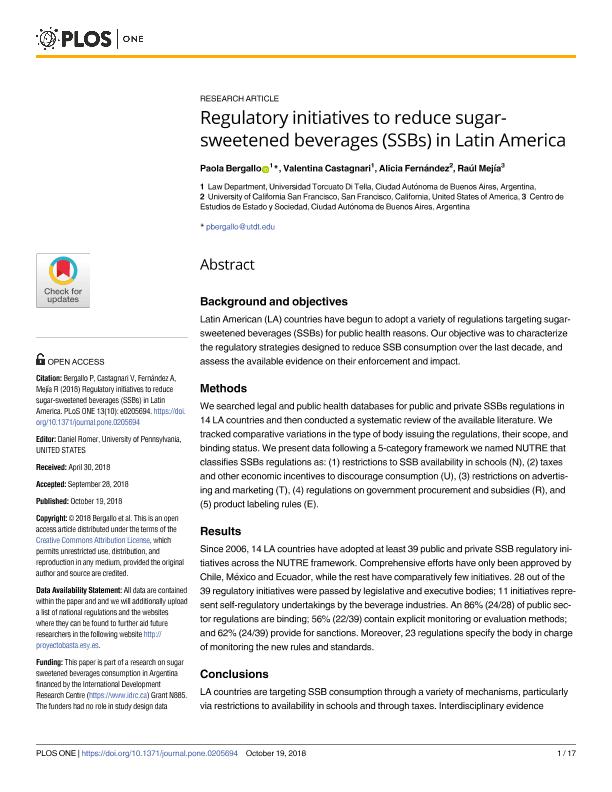Mostrar el registro sencillo del ítem
dc.contributor.author
Bergallo, Paola

dc.contributor.author
Castagnari, Valentina

dc.contributor.author
Fernández, Alicia
dc.contributor.author
Mejia, Raul Mariano

dc.date.available
2020-02-21T21:43:14Z
dc.date.issued
2018-10
dc.identifier.citation
Bergallo, Paola; Castagnari, Valentina; Fernández, Alicia; Mejia, Raul Mariano; Regulatory initiatives to reduce sugar-sweetened beverages (SSBs) in Latin America; Public Library of Science; Plos One; 13; 10; 10-2018; 1-17; e0205694
dc.identifier.issn
1932-6203
dc.identifier.uri
http://hdl.handle.net/11336/98370
dc.description.abstract
Background and objectives Latin American (LA) countries have begun to adopt a variety of regulations targeting sugarsweetened beverages (SSBs) for public health reasons. Our objective was to characterize the regulatory strategies designed to reduce SSB consumption over the last decade, and assess the available evidence on their enforcement and impact. Methods We searched legal and public health databases for public and private SSBs regulations in 14 LA countries and then conducted a systematic review of the available literature. We tracked comparative variations in the type of body issuing the regulations, their scope, and binding status. We present data following a 5-category framework we named NUTRE that classifies SSBs regulations as: (1) restrictions to SSB availability in schools (N), (2) taxes and other economic incentives to discourage consumption (U), (3) restrictions on advertising and marketing (T), (4) regulations on government procurement and subsidies (R), and (5) product labeling rules (E). Results Since 2006, 14 LA countries have adopted at least 39 public and private SSB regulatory initiatives across the NUTRE framework. Comprehensive efforts have only been approved by Chile, México and Ecuador, while the rest have comparatively few initiatives. 28 out of the 39 regulatory initiatives were passed by legislative and executive bodies; 11 initiatives represent self-regulatory undertakings by the beverage industries. An 86% (24/28) of public sector regulations are binding; 56% (22/39) contain explicit monitoring or evaluation methods; and 62% (24/39) provide for sanctions. Moreover, 23 regulations specify the body in charge of monitoring the new rules and standards. Conclusions LA countries are targeting SSB consumption through a variety of mechanisms, particularly via restrictions to availability in schools and through taxes. Interdisciplinary evidence comparing alternative regulatory strategies is scarce, and few studies offer data on impact and implementation challenges. More evidence and further comparative assessments are needed to support future decision-making.
dc.format
application/pdf
dc.language.iso
eng
dc.publisher
Public Library of Science

dc.rights
info:eu-repo/semantics/openAccess
dc.rights.uri
https://creativecommons.org/licenses/by-nc-sa/2.5/ar/
dc.subject
Bebidas Azucaradas
dc.subject
Regulación
dc.subject
América Latina
dc.subject.classification
Otras Derecho

dc.subject.classification
Derecho

dc.subject.classification
CIENCIAS SOCIALES

dc.title
Regulatory initiatives to reduce sugar-sweetened beverages (SSBs) in Latin America
dc.type
info:eu-repo/semantics/article
dc.type
info:ar-repo/semantics/artículo
dc.type
info:eu-repo/semantics/publishedVersion
dc.date.updated
2020-02-18T16:04:41Z
dc.journal.volume
13
dc.journal.number
10
dc.journal.pagination
1-17; e0205694
dc.journal.pais
Estados Unidos

dc.journal.ciudad
San Francisco
dc.description.fil
Fil: Bergallo, Paola. Consejo Nacional de Investigaciones Científicas y Técnicas; Argentina. Universidad Torcuato Di Tella; Argentina
dc.description.fil
Fil: Castagnari, Valentina. Universidad Torcuato Di Tella; Argentina
dc.description.fil
Fil: Fernández, Alicia. University of California; Estados Unidos
dc.description.fil
Fil: Mejia, Raul Mariano. Centro de Estudios de Estado y Sociedad; Argentina
dc.journal.title
Plos One

dc.relation.alternativeid
info:eu-repo/semantics/altIdentifier/doi/http://dx.doi.org/10.1371/journal.pone.0205694
dc.relation.alternativeid
info:eu-repo/semantics/altIdentifier/url/https://journals.plos.org/plosone/article?id=10.1371/journal.pone.0205694
Archivos asociados
